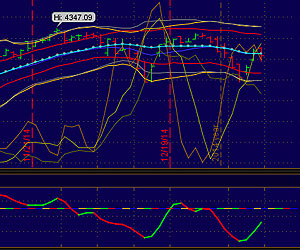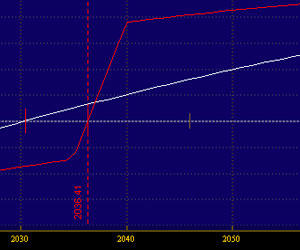Thank you for your interest in my trading systems development and quantitative finance projects. Here are a few of the most common questions people ask me about my nearly 20 years of research and work related to this field…
Bill, what is your trading philosophy?
As for timing underlying price action, I am most partial to probability and momentum measures, these days.

Using a hand full of proprietary studies – I developed a few and also use a couple standard ones – I mix those with classic technical analysis patterns for entries and exits.
I have also worked on a few experimental systems with strategic focus ranging from neural networks to time cycles but I still favor keeping things simple with rules based identifying of opportunities and discretionary abstention.
What instruments do you design trading systems for?
As for trading instruments, I love options on the S&P 500 cash market (SPX) and Nasdaq 100 (NDX).
A few of the strategies I’m testing focus on weekly optionable stocks and ETFs with high implied volatility but my most effective systems sell option premium on the broader market indexes with a biased delta to delta neutral strategy depending on market conditions.
For price action, I usually have a direction in mind and we are rarely caught by surprise but capturing decay of theta and changes in volatility add the frosting on the cake.
How well do your best trading systems perform?
Though the production ready strategies do benefit from forecasted movement in market price, they still perform when the market sits stagnate in a range because the majority of profit arrives through the decay of time value and volatility premium in the options contracts themselves.
 In fact, that is one of the reasons why they work so well – because I’ve built these particular systems with a philosophy of selling insurance on where the market won’t be based on probability and momentum instead of purely trying to forecast where prices will go.
In fact, that is one of the reasons why they work so well – because I’ve built these particular systems with a philosophy of selling insurance on where the market won’t be based on probability and momentum instead of purely trying to forecast where prices will go.
Expected timeframes for most trades are typically 2 to 45 days. Expected return on required capital varies per system and I would prefer to grow the track record further on most of the systems before releasing that data but, obviously, for real time simulation and live testing between iterations, that takes patience and time. However, without swinging for the fences, even a very realistic average account goal of 1% to 5% per month (often more) with minimal risk compounds nicely over time.
Above all, and really what I believe sets my work apart, my objective has been to create scalable systems that can be calibrated to any given client’s capitalization, risk tolerance, and revenue goals. Results from my best performing systems demonstrate to me that I am doing that effectively.
For your trading and quantitative finance projects, are you hiring, looking for partners, or accepting hedge fund clients?
Yes, actually. A colleague and I are looking to seed a small trading fund and if you are savvy with raising early stage funds for management, I would love to hear from you since my focus has primarily been data and analytics for systems development. Along the same line, if you and your team would like to license trading systems for your fund (systems with managed services model), please connect with me about your goals via the contact page.
If I meet accredited investor or qualified client requirements, can you help me?
Please connect with me about your goals via the contact page.
Do you develop systems for HFT?
At this time, no. My recent focus has mainly been with timeframes greater than one hour and the results are great. I have also suspended work on the ES futures or e-mini futures scalping systems because they are a little nerve wracking to me and suitable market conditions are too infrequently available for my liking. However, I still like to occasionally revisit them when volatility heats up.
Why are trading systems so important?
One of the hedge fund clients I’ve worked with as a programmer had a trading desk mantra that I’m frequently reminded of. A sign above their screens read: “A lot of singles. No home runs.”
These three guys privately managed around four billion in assets. Some from international investors but mostly local iconic Texas wealth. With that reference to baseball, they recalibrated thinking to a more skillful approach that would work on the best days, the worst days, and could stand the test of time.
 As with any discipline or craft, without recipes or repeatable systems, you will be constantly forced to improvise or reinvent the wheel.
As with any discipline or craft, without recipes or repeatable systems, you will be constantly forced to improvise or reinvent the wheel.
Not only does that lack of planning reduce efficiency, doing that as a trader makes it more about luck and skill which becomes more about ego, desire, and always needing to be right… then that becomes more about greed, fear, stress, excitement, anxiety, and the occasional self-loathing.
These things rarely benefit long term profitability.
It really comes down to the question of why would anyone put up with theatrics when your only job is to harvest profit and you can simply let the numbers make most of the decisions for you?
I’m an individual with a small portfolio, can I invest in your fund?
Not at this time. I’m not set up for that at all yet (if ever). However, if you would like to be updated on future announcements for any of the various tech and trading projects, you can sign up for email updates.
How can I learn how to trade for my own account?
Good question. Register your email for updates and follow me on social media. I will alert you when I offer a workshop or course.